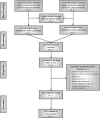Evaluating influential factors of acupuncture for tension-type headache: A protocol for systematic review and meta-analysis
- PMID: 33181682
- PMCID: PMC7668429
- DOI: 10.1097/MD.0000000000023118
Evaluating influential factors of acupuncture for tension-type headache: A protocol for systematic review and meta-analysis
Abstract
Background: Acupuncture has been recommended for the treatment of tension-type headache (TTH). However inconsistent findings on the efficacy of acupuncture impacts on the uptake of this effective therapy for TTH. This systematic review aims to 1) Evaluate the efficacy of acupuncture for TTH; and 2) Clarify the factors contributing to conflicting findings through conducting a meta-analysis and meta-regression of randomized controlled trials.
Methods: Comprehensive literature search will be performed on PubMed, EMBASE, CINAHL, ProQuest, Cochrane Central Register of Controlled Trials, Acubriefs, ScienceDirect, Scopus, AMED, and 4 leading Chinese databases of the China National Knowledge Infrastructure, China Science and Technology Journal Database, Wanfang Data, and CBM (SinoMed). We will include Randomized controlled Trials or controlled trials of patients with TTH that compared acupuncture with sham interventions. The primary outcome is the number of days on headache (within 4 weeks) at the end of the treatment and follow-ups. Secondary outcomes include intensity of pain, frequency of attack, and the adverse effects resulting from the intervention. We will use pre-defined sub-group analysis and meta-regression to explore the influential factors of acupuncture effects. Heterogeneity assessment will be performed before carrying out meta-analysis, whereas the subgroup analyses and meta-regression will be used in verifying the possible factors of heterogeneity when significant heterogeneity detected.
Results: Review Manager 5.3 software will be used for meta-analysis. The synthesis will be performed by generating forest plots. Meta-regression will be used to understand influential factors for acupuncture in patients with TTH.
Conclusion: By utilizing techniques of meta-regression, this study will provide evidence toward to a more focused understanding of influential factors for acupuncture in patients with TTH. This systematic review will provide quality evidence for the optimization of acupuncture therapeutic regimen. It will facilitate the development of clinical practice guideline on acupuncture for TTH.
Conflict of interest statement
The authors have no conflicts of interest to disclose.
Figures
References
-
- Vos T, Barber R, Bell B, et al. Global, regional, and national incidence, prevalence, and years lived with disability for 301 acute and chronic diseases and injuries in 188 countries, 1990-2013: a systematic analysis for the global burden of disease study 2013. Lancet 2015;386:743–800. - PMC - PubMed
-
- Devlin I. Selvaratnam P, Niere K, Zuluaga M. Headache in general practice. Churchill Livingstone, Headache, Orofacial Pain and Bruxism. Edinburgh: 2009.
-
- Mueller L. Tension-type, the forgotten headache. How to recognize this common but undertreated condition. Postgrad Med 2002;111:25–6. - PubMed
-
- Jensen R. Diagnosis epidemiology and impact of tension-type headache. Curr Pain Headache Rep 2003;7:455–9. - PubMed
-
- Ezzo J, Berman B, Hadhazy VA, et al. Is acupuncture effective for the treatment of chronic pain? A systematic review. Pain 2000;86:217–25. - PubMed
MeSH terms
LinkOut - more resources
Full Text Sources
Medical


